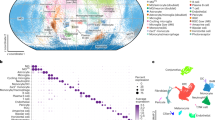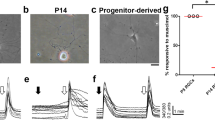Abstract
The optic nerve, like most mature CNS pathways, does not regenerate after injury. Through unknown mechanisms, however, macrophage activation in the eye stimulates retinal ganglion cells (RGCs) to regenerate long axons beyond the site of optic nerve injury. Here we identify the calcium (Ca2+)-binding protein oncomodulin as a potent macrophage-derived growth factor for RGCs and other neurons. Oncomodulin binds to rat RGCs with high affinity in a cyclic AMP (cAMP)-dependent manner and stimulates more extensive outgrowth than other known trophic agents. Depletion of oncomodulin from macrophage-conditioned media (MCM) eliminates the axon-promoting activity of MCM. The effects of oncomodulin involve downstream signaling via Ca2+/calmodulin kinase and gene transcription. In vivo, oncomodulin released from microspheres promotes regeneration in the mature rat optic nerve. Oncomodulin also stimulates outgrowth from peripheral sensory neurons. Thus, oncomodulin is a new growth factor for neurons of the mature central and peripheral nervous systems.
This is a preview of subscription content, access via your institution
Access options
Subscribe to this journal
Receive 12 print issues and online access
$209.00 per year
only $17.42 per issue
Buy this article
- Purchase on Springer Link
- Instant access to full article PDF
Prices may be subject to local taxes which are calculated during checkout







Similar content being viewed by others
References
Ramon y Cajal, S. Degeneration and Regeneration of the Nervous System (Oxford Univ. Press, New York, 1991).
Aguayo, A.J. et al. Degenerative and regenerative responses of injured neurons in the central nervous system of adult mammals. Philos. Trans. R. Soc. Lond. B Biol. Sci. 331, 337–343 (1991).
Chierzi, S., Strettoi, E., Cenni, M.C. & Maffei, L. Optic nerve crush: axonal responses in wild-type and bcl-2 transgenic mice. J. Neurosci. 19, 8367–8376 (1999).
Shen, S., Wiemelt, A.P., McMorris, F.A. & Barres, B.A. Retinal ganglion cells lose trophic responsiveness after axotomy. Neuron 23, 285–295 (1999).
Monsul, N.T. et al. Intraocular injection of dibutyryl cyclic AMP promotes axon regeneration in rat optic nerve. Exp. Neurol. 186, 124–133 (2004).
Kermer, P., Klocker, N., Labes, M. & Bahr, M. Inhibition of CPP32-like proteases rescues axotomized retinal ganglion cells from secondary cell death in vivo. J. Neurosci. 18, 4656–4662 (1998).
Mey, J. & Thanos, S. Intravitreal injections of neurotrophic factors support the survival of axotomized retinal ganglion cells in adult rats in vivo. Brain Res. 602, 304–317 (1993).
Pernet, V. & Di Polo, A. Synergistic action of brain-derived neurotrophic factor and lens injury promotes retinal ganglion cell survival, but leads to optic nerve dystrophy in vivo. Brain (2006).
Koeberle, P.D. & Ball, A.K. Effects of GDNF on retinal ganglion cell survival following axotomy. Vision Res. 38, 1505–1515 (1998).
Cheng, L., Sapieha, P., Kittlerova, P., Hauswirth, W.W. & Di Polo, A. TrkB gene transfer protects retinal ganglion cells from axotomy-induced death in vivo. J. Neurosci. 22, 3977–3986 (2002).
Zhou, Y., Pernet, V., Hauswirth, W.W. & Di Polo, A. Activation of the extracellular signal-regulated kinase 1/2 pathway by AAV gene transfer protects retinal ganglion cells in glaucoma. Mol. Ther. 12, 402–412 (2005).
Weibel, D., Cadelli, D. & Schwab, M.E. Regeneration of lesioned rat optic nerve fibers is improved after neutralization of myelin-associated neurite growth inhibitors. Brain Res. 642, 259–266 (1994).
Fischer, D., He, Z. & Benowitz, L.I. Counteracting the Nogo receptor enhances optic nerve regeneration if retinal ganglion cells are in an active growth state. J. Neurosci. 24, 1646–1651 (2004).
Lehmann, M. et al. Inactivation of Rho signaling pathway promotes CNS axon regeneration. J. Neurosci. 19, 7537–7547 (1999).
Fischer, D., Petkova, V., Thanos, S. & Benowitz, L.I. Switching mature retinal ganglion cells to a robust growth state in vivo: gene expression and synergy with RhoA inactivation. J. Neurosci. 24, 8726–8740 (2004).
Koprivica, V. et al. EGFR activation mediates inhibition of axon regeneration by myelin and chondroitin sulfate proteoglycans. Science 310, 106–110 (2005).
Berry, M., Carlile, J. & Hunter, A. Peripheral nerve explants grafted into the vitreous body of the eye promote the regeneration of retinal ganglion cell axons severed in the optic nerve. J. Neurocytol. 25, 147–170 (1996).
Leon, S., Yin, Y., Nguyen, J., Irwin, N. & Benowitz, L.I. Lens injury stimulates axon regeneration in the mature rat optic nerve. J. Neurosci. 20, 4615–4626 (2000).
Fischer, D., Heiduschka, P. & Thanos, S. Lens-injury-stimulated axonal regeneration throughout the optic pathway of adult rats. Exp. Neurol. 172, 257–272 (2001).
Lorber, B., Berry, M. & Logan, A. Lens injury stimulates adult mouse retinal ganglion cell axon regeneration via both macrophage- and lens-derived factors. Eur. J. Neurosci. 21, 2029–2034 (2005).
Yin, Y. et al. Macrophage-derived factors stimulate optic nerve regeneration. J. Neurosci. 23, 2284–2293 (2003).
Li, Y., Irwin, N., Yin, Y., Lanser, M. & Benowitz, L.I. Axon regeneration in goldfish and rat retinal ganglion cells: differential responsiveness to carbohydrates and cAMP. J. Neurosci. 23, 7830–7838 (2003).
Lorber, B., Berry, M., Logan, A. & Tonge, D. Effect of lens lesion on neurite outgrowth of retinal ganglion cells in vitro. Mol. Cell. Neurosci. 21, 301–311 (2002).
MacManus, J.P., Whitfield, J.F., Boynton, A.L., Durkin, J.P. & Swierenga, S.H. Oncomodulin–a widely distributed, tumour-specific, calcium-binding protein. Oncodev. Biol. Med. 3, 79–90 (1982).
Henzl, M.T., Larson, J.D. & Agah, S. Influence of monovalent cation identity on parvalbumin divalent ion-binding properties. Biochemistry 43, 2747–2763 (2004).
Henzl, M.T., Shibasaki, O., Comegys, T.H., Thalmann, I. & Thalmann, R. Oncomodulin is abundant in the organ of Corti. Hear. Res. 106, 105–111 (1997).
Meyer-Franke, A., Kaplan, M.R., Pfrieger, F.W. & Barres, B.A. Characterization of the signaling interactions that promote the survival and growth of developing retinal ganglion cells in culture. Neuron 15, 805–819 (1995).
Jo, S., Wang, E. & Benowitz, L.I. CNTF is an endogenous axon regeneration factor for mammalian retinal ganglion cells. Neuroscience 89, 579–591 (1999).
Mansour-Robaey, S., Clarke, D.B., Wang, Y.C., Bray, G.M. & Aguayo, A.J. Effects of ocular injury and administration of brain-derived neurotrophic factor on survival and regrowth of axotomized retinal ganglion cells. Proc. Natl. Acad. Sci. USA 91, 1632–1636 (1994).
Cui, Q., Yip, H.K., Zhao, R.C., So, K.F. & Harvey, A.R. Intraocular elevation of cyclic AMP potentiates ciliary neurotrophic factor-induced regeneration of adult rat retinal ganglion cell axons. Mol. Cell. Neurosci. 22, 49–61 (2003).
Barres, B.A., Silverstein, B.E., Corey, D.P. & Chun, L.L. Immunological, morphological, and electrophysiological variation among retinal ganglion cells purified by panning. Neuron 1, 791–803 (1988).
Maune, J.F., Beckingham, K., Martin, S.R. & Bayley, P.M. Circular dichroism studies on calcium binding to two series of Ca2+ binding site mutants of Drosophila melanogaster calmodulin. Biochemistry 31, 7779–7786 (1992).
Pauls, T.L., Cox, J.A. & Berchtold, M.W. The Ca2+-binding proteins parvalbumin and oncomodulin and their genes: new structural and functional findings. Biochim. Biophys. Acta 1306, 39–54 (1996).
Meyer-Franke, A. et al. Depolarization and cAMP elevation rapidly recruit TrkB to the plasma membrane of CNS neurons. Neuron 21, 681–693 (1998).
Cai, D., Shen, Y., De Bellard, M., Tang, S. & Filbin, M.T. Prior exposure to neurotrophins blocks inhibition of axonal regeneration by MAG and myelin via a cAMP-dependent mechanism. Neuron 22, 89–101 (1999).
MacMicking, J., Xie, Q.W. & Nathan, C. Nitric oxide and macrophage function. Annu. Rev. Immunol. 15, 323–350 (1997).
Steinmetz, M.P. et al. Chronic enhancement of the intrinsic growth capacity of sensory neurons combined with the degradation of inhibitory proteoglycans allows functional regeneration of sensory axons through the dorsal root entry zone in the mammalian spinal cord. J. Neurosci. 25, 8066–8076 (2005).
Lu, X. & Richardson, P.M. Inflammation near the nerve cell body enhances axonal regeneration. J. Neurosci. 11, 972–978 (1991).
Rapalino, O. et al. Implantation of stimulated homologous macrophages results in partial recovery of paraplegic rats. Nat. Med. 4, 814–821 (1998).
Porter, A.C. et al. M1 muscarinic receptor signaling in mouse hippocampus and cortex. Brain Res. 944, 82–89 (2002).
Buxser, S., Decker, D. & Ruppel, P. Relationship among types of nerve growth factor receptors on PC12 cells. J. Biol. Chem. 265, 12701–12710 (1990).
Goldberg, J.L. et al. Retinal ganglion cells do not extend axons by default: promotion by neurotrophic signaling and electrical activity. Neuron 33, 689–702 (2002).
Streilein, J.W., Wilbanks, G.A., Taylor, A. & Cousins, S. Eye-derived cytokines and the immunosuppressive intraocular microenvironment: a review. Curr. Eye Res. 11 Suppl: 41–47 (1992).
Cohen-Cory, S. & Fraser, S.E. Effects of brain-derived neurotrophic factor on optic axon branching and remodelling in vivo. Nature 378, 192–196 (1995).
McKinnon, S.J. et al. Baculoviral IAP repeat-containing-4 protects optic nerve axons in a rat glaucoma model. Mol. Ther. 5, 780–787 (2002).
Otori, Y., Wei, J.Y. & Barnstable, C.J. Neurotoxic effects of low doses of glutamate on purified rat retinal ganglion cells. Invest. Ophthalmol. Vis. Sci. 39, 972–981 (1998).
Hapak, R.C., Lammers, P.J., Palmisano, W.A., Birnbaum, E.R. & Henzl, M.T. Site-specific substitution of glutamate for aspartate at position 59 of rat oncomodulin. J. Biol. Chem. 264, 18751–18760 (1989).
Flanagan, J.G. et al. Alkaline phosphatase fusions of ligands or receptors as in situ probes for staining of cells, tissues, and embryos. Methods Enzymol. 327, 19–35 (2000).
Fu, K. et al. A potential approach for decreasing the burst effect of protein from PLGA microspheres. J. Pharm. Sci. 92, 1582–1591 (2003).
Gavazzi, I., Kumar, R.D., McMahon, S.B. & Cohen, J. Growth responses of different subpopulations of adult sensory neurons to neurotrophic factors in vitro. Eur. J. Neurosci. 11, 3405–3414 (1999).
Acknowledgements
We would like to thank Y. Li for assistance in preparing fusion proteins, H. He for designing and analyzing binding assays, M. Berry for instruction in surgical methods for DRG injections, the Harvard Microchemistry Facility for carrying out the mass spectrometry analysis, and P. Rosenberg, N. Irwin, T. Schwarz, G. Corfas and D. Goldberg for comments on the manuscript. This paper is dedicated to the memory of Yin Xuequan, who inspired Y.Y.'s scientific career. Supported by the US National Institutes of Health (EY 05690), the Patterson Family Trust, the European Commission (MOIF-CT-2004-008424) and Boston Life Sciences, Inc.
Author information
Authors and Affiliations
Contributions
Y.Y. isolated oncomodulin, conducted all bioassays and binding assays on RGCs, performed the immunolocalization and RT-PCR studies, prepared the oncomodulin mutant proteins, conducted in vivo experiments and initial studies on DRG neurons and drafted the manuscript. M.T.H. provided background information on oncomodulin, plasmids and recombinant protein. B.L. contributed to the in vivo and in vitro studies on DRG neurons. T.N. conducted the immunoisolation of RGCs and the P-CREB studies in vivo. T.T.T. prepared the PLGA microspheres. F.J. provided technical assistance for many studies. R.L. supervised the microsphere preparation. L.I.B. supervised the project, conducted database searches and data analyses, and prepared the final manuscript and figures.
Corresponding author
Ethics declarations
Competing interests
Larry Benowitz is paid for consulting to Boston Life Sciences, Inc. (BLSI), which has the commercial rights of Oncomodulin. BLSI also provided a limited amount of financial support for this research. Robert Langer is a member of the Scientific Advisory Board of BLSI.
Supplementary information
Supplementary Fig. 1
Macrophage secretion of oncomodulin vs. superoxide dismutase (SOD). (PDF 262 kb)
Rights and permissions
About this article
Cite this article
Yin, Y., Henzl, M., Lorber, B. et al. Oncomodulin is a macrophage-derived signal for axon regeneration in retinal ganglion cells. Nat Neurosci 9, 843–852 (2006). https://doi.org/10.1038/nn1701
Received:
Accepted:
Published:
Issue Date:
DOI: https://doi.org/10.1038/nn1701
This article is cited by
-
Purified regenerating retinal neurons reveal regulatory role of DNA methylation-mediated Na+/K+-ATPase in murine axon regeneration
Communications Biology (2023)
-
Regulated Cell Death of Retinal Ganglion Cells in Glaucoma: Molecular Insights and Therapeutic Potentials
Cellular and Molecular Neurobiology (2023)
-
Retinal ganglion cell repopulation for vision restoration in optic neuropathy: a roadmap from the RReSTORe Consortium
Molecular Neurodegeneration (2023)
-
Solving neurodegeneration: common mechanisms and strategies for new treatments
Molecular Neurodegeneration (2022)
-
Transcription factor network analysis identifies REST/NRSF as an intrinsic regulator of CNS regeneration in mice
Nature Communications (2022)



